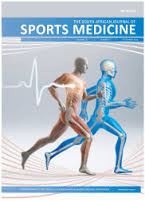The relationship between core stability and athletic performance in female university athletes
DOI:
https://doi.org/10.17159/2078-516X/2021/v33i1a10825Abstract
Background: Questions remain as to whether core stability represents a single or more components, how to assess core stability, and if a relationship exists with athletic performance in different sport codes.
Objectives: To investigate the relationship between core stability and athletic performance in female university athletes.
Methods: Eighty-three female athletes (hockey, netball, running, soccer and tennis) participated in this quantitative, cross-sectional study. The isometric back extension (IBE), lateral flexion (LF) and abdominal flexion (AF) tests were used to measure core strength and endurance. The core stability grading system using a pressure biofeedback unit was applied to measure core neuromuscular control (NMC). Athletic performance was assessed using the 40 m sprint, T-test, vertical jump (VJ) and the medicine ball chest throw (MBCT). Correlations between the core stability tests and the athletic performance tests were determined, overall and separately by sport. The effect of core stability on athletic performance was analysed using ANCOVA.
Results: Most correlations were weak (r=0.10–0.39), although a very strong correlation was found between LF (strength) and VJ (r=0.90). When considered separately, moderate correlations (r=0.40–0.69) were found between core strength, endurance and motor control with certain athletic performance tests in all five sport codes. In runners, strong correlations (r=0.70–0.89) occurred between AF (endurance) and VJ, and in tennis players between IBE (strength) and the sprint.
Conclusion: Correlations were found between core stability and athletic performance, although most correlations were negligible or weak. Athletic performance in different sport codes is associated with different components of core stability.
Downloads
Downloads
Published
Issue
Section
License
Copyright (c) 2021 South African Journal of Sports Medicine

This work is licensed under a Creative Commons Attribution 4.0 International License.
The South African Journal of Sports Medicine reserves copyright of the material published. The work is licensed under a Creative Commons Attribution 4.0 (CC BY 4.0) International License. Material submitted for publication in the South African Journal of Sports Medicine is accepted provided it has not been published elsewhere. The South African Journal of Sports Medicine does not hold itself responsible for statements made by the authors.
How to Cite
- Abstract 895
- PDF 713





.png)